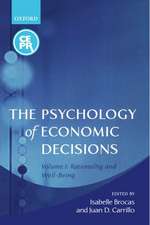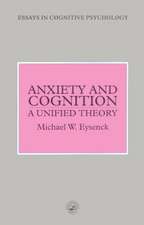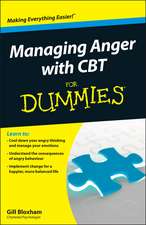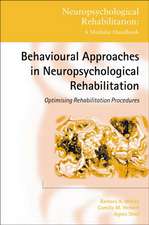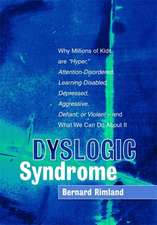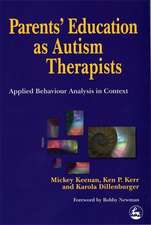The Science of Learning
Autor Joseph J. Pearen Limba Engleză Paperback – 11 mar 2016
| Toate formatele și edițiile | Preț | Express |
|---|---|---|
| Paperback (1) | 376.57 lei 6-8 săpt. | |
| Taylor & Francis – 11 mar 2016 | 376.57 lei 6-8 săpt. | |
| Hardback (1) | 856.71 lei 6-8 săpt. | |
| Taylor & Francis – 10 mar 2016 | 856.71 lei 6-8 săpt. |
Preț: 376.57 lei
Preț vechi: 480.81 lei
-22% Nou
Puncte Express: 565
Preț estimativ în valută:
72.08€ • 78.32$ • 60.59£
72.08€ • 78.32$ • 60.59£
Carte tipărită la comandă
Livrare economică 21 aprilie-05 mai
Preluare comenzi: 021 569.72.76
Specificații
ISBN-13: 9781848724730
ISBN-10: 184872473X
Pagini: 516
Ilustrații: 2 black & white tables, 25 black & white line drawings
Dimensiuni: 178 x 229 x 30 mm
Greutate: 0.79 kg
Ediția:Revised
Editura: Taylor & Francis
Colecția Routledge
Locul publicării:Oxford, United Kingdom
ISBN-10: 184872473X
Pagini: 516
Ilustrații: 2 black & white tables, 25 black & white line drawings
Dimensiuni: 178 x 229 x 30 mm
Greutate: 0.79 kg
Ediția:Revised
Editura: Taylor & Francis
Colecția Routledge
Locul publicării:Oxford, United Kingdom
Cuprins
CONTENTS
PREFACE ……………………………………………………………………………
PART I. BASIC TERMS AND CONCEPTS ………...…………………………………
Chapter One. INTRODUCTION …………………………………………………
Chapter Two. NonAssociative Learning ………………………………………………………………………………………….
Chapter Three. Associative Learning ………………………………..
Chapter Four. BASIC RESPONDENT AND OPERANT PROCESSES ……
Chapter FIVE. Derivatives of Associative Learning ………….
part II. BASIC stimulus-stimulus and response-stimulus contingencies ……………………………………………………………….…
Chapter Six. STIMULUS PAIRINGS ACROSS RESPONSE SYSTEMS ….
Chapter Seven. BASIC OPERANT BEHAVIOR ………………………….. part III. COMPLEX CONTINGENCIES ……………………………………....Chapter Eight. STIMULUS CONTROL: DISCRIMINATION AND GENERALIZATION ………………………………………………………………
Chapter Nine. CONDITIONAL DISCRIMINATIONS AND EQUIVALENCE CLASSES ……………………………………………………………………………………….Chapter Ten. Memory: Stimulus Discrimination across Time………………………………………………………………………………...CHAPTER 11. CONDITIONED REINFORCEMENT ………………………… Chapter Twelve. CONCURRENT SCHEDULES, CHOICE, AND PREFERENCE ……………………………………………………………………..
part IV. MOTIVATION AND EMOTION ……………………………………… Chapter Thirteen. MOTIVATION ……………………………………………..................................................................Chapter Fourteen. PUNISHMENT …………………………………………………………………………………..…..Chapter Fifteen. ADJUNCTIVE BEHAVIOR ……………………………………………………………………………………….
part V. EXTENSIONS TO NATURAL SETTINGS 359 …………………… …Chapter Sixteen. Animals in their Natural Environments ……………………………………………………………………………………….
Chapter Seventeen. HUMANS IN SOCIAL ENVIRONMENTS …….. GLOSSARY ……………………………………………………..……………......
APPENDICES …………………………………………………………….............
APPENDiX A …………………………………………………………….............
APPENDiX B …………………………………………………………….............
APPENDiX C …………………………………………………………….............
APPENDiX D …………………………………………………………….............
APPENDiX E …………………………………………………………….............
REFERENCES ……………………………………………………………….…
PREFACE ……………………………………………………………………………
PART I. BASIC TERMS AND CONCEPTS ………...…………………………………
Chapter One. INTRODUCTION …………………………………………………
Chapter Two. NonAssociative Learning ………………………………………………………………………………………….
Chapter Three. Associative Learning ………………………………..
Chapter Four. BASIC RESPONDENT AND OPERANT PROCESSES ……
Chapter FIVE. Derivatives of Associative Learning ………….
part II. BASIC stimulus-stimulus and response-stimulus contingencies ……………………………………………………………….…
Chapter Six. STIMULUS PAIRINGS ACROSS RESPONSE SYSTEMS ….
Chapter Seven. BASIC OPERANT BEHAVIOR ………………………….. part III. COMPLEX CONTINGENCIES ……………………………………....Chapter Eight. STIMULUS CONTROL: DISCRIMINATION AND GENERALIZATION ………………………………………………………………
Chapter Nine. CONDITIONAL DISCRIMINATIONS AND EQUIVALENCE CLASSES ……………………………………………………………………………………….Chapter Ten. Memory: Stimulus Discrimination across Time………………………………………………………………………………...CHAPTER 11. CONDITIONED REINFORCEMENT ………………………… Chapter Twelve. CONCURRENT SCHEDULES, CHOICE, AND PREFERENCE ……………………………………………………………………..
part IV. MOTIVATION AND EMOTION ……………………………………… Chapter Thirteen. MOTIVATION ……………………………………………..................................................................Chapter Fourteen. PUNISHMENT …………………………………………………………………………………..…..Chapter Fifteen. ADJUNCTIVE BEHAVIOR ……………………………………………………………………………………….
part V. EXTENSIONS TO NATURAL SETTINGS 359 …………………… …Chapter Sixteen. Animals in their Natural Environments ……………………………………………………………………………………….
Chapter Seventeen. HUMANS IN SOCIAL ENVIRONMENTS …….. GLOSSARY ……………………………………………………..……………......
APPENDICES …………………………………………………………….............
APPENDiX A …………………………………………………………….............
APPENDiX B …………………………………………………………….............
APPENDiX C …………………………………………………………….............
APPENDiX D …………………………………………………………….............
APPENDiX E …………………………………………………………….............
REFERENCES ……………………………………………………………….…
Notă biografică
Joseph J. Pear received his B.S. from the University of Maryland and M.A. and Ph.D. from The Ohio State University. He is currently a professor of psychology at the University of Manitoba. A fellow of Division 6 (Behavioral Neuroscience and Comparative Psychology) and Division 25 (Behavior Analysis) of the American Psychological Association, Pear does both basic and applied behavioral research. For his applied research, he developed the Computer-Aided Personal System of Instruction (CAPSI), an instructional program based on the Keller Plan. CAPSI is an award winning web-based program that is used to teach courses at the University of Manitoba and other universities in Canada and the United States. It is also a research tool that he and his graduate and undergraduate students use to study the teaching and learning dimensions of university education and institutional staff training. For his basic research, he developed a video-training system that he and his graduate and undergraduate students have used to study pigeon operant behavior and currently use to study fish operant behavior. In addition to The Science of Learning, Pear has written two other books, also published by Taylor & Francis: Behavior Modification: What It Is and How to Do It with Garry Martin, now in its 10th edition, and A Historical and Contemporary Look at Psychological Systems. Pear has also written numerous research articles, book chapters, and encyclopedia articles.
Descriere
This text comprehensively and systematically covers the large body of knowledge and powerful methodologies and applications that have developed in the science of learning since the late 19th Century. It starts with the most fundamental principles and progresses toward greater complexity. The connections with biology and evolutionary science are referenced throughout, and there is coverage of both humans and animals in their natural settings. It may be used as a primary text in courses on learning, behavior analysis and conditioning, and is a resource for professional and trainee behavior analysts and those in biology, education, and clinical psychology.


